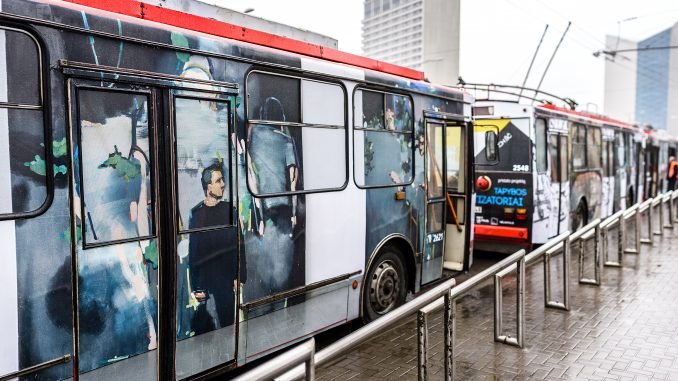
The street art that is characteristic of the city has taken to the roads in a new project entitled ‘Painting Routers’. Launched this week by local contemporary art gallery Art LAB, Painting Routers has turned four of Vilnius’ trolleybuses into mobile urban canvases displaying the work of eight renowned local painters throughout the city.
The project – which will run for three months – aims to acquaint residents of Vilnius and visitors alike with these exceptional young artists while supporting their work and evolving perceptions of the world they inhabit. The artists involved in the project include Linas Jusionis, Adomas Danusevičius, Andrius Zakarauskas, Darius Jaruševičius, Ina Šilina, Indrė Ercmonaitė, Simonas Kuliešis and Jolanta Kyzikaitė. Most of them are graduates of the Vilnius Academy of Fine Arts and regularly exhibit their work at local galleries and museums, and take part in cultural events like the annual ‘ArtVilnius’ fair.
With the sides of trolleybuses being used as canvases, the project reflects the fact that painting as an art medium can take on many forms and can be communicated through informal means. Moreover, contemporary art is not bound to the traditions it stems from, and can easily be influenced by the rapidly evolving technologies characteristic of our era.
Director of the official development agency of the City of Vilnius Darius Udrys is supportive of the initiative and interprets its message to mean a lot of different things for his city. “Vilnius is open to new ideas, like the Painting Routers initiative. Not only does this project support our young artists and bring attention to the contemporary art scene in our city, it also illustrates the dynamic nature of art, which increasingly extends past traditional limits and exhibition spaces, and finds inspiration in the present and the technologies that are available to us. It’s about much more than integrating art into public spaces around the city, it’s about initiating a creative dialogue between generations, which ultimately makes using public transport a unique and more exciting experience for everyone,” he says.
The Painting Routers project and the dialogue it encourages speak to a variety of broader ideas pertaining to Vilnius, too. It does indeed reflect a city that is open to ideas and welcoming of opportunities for collaboration. It also reminds visitors and foreigners taking up residence in Vilnius that the city features traditional characteristics but is also thriving on the now. And of course, the influence technology has on the city, both in leisure and professional settings, is something that cannot be overlooked.
Add to this the fact that Vilnius is easily accessible from all over Europe, boasts vast urban green spaces ideal for all kinds of outdoor activities and a charming Old Town that is featured on UNESCO’s World Heritage List, and the mix between honouring the past and ushering in the present is even more apparent.
Vilnius proudly supports its contemporary arts scene, and one need look no further than the large-scale events held each year to promote the arts as evidence of this. These include the Book Fair, the International Film Festival, and the International Art Fair ArtVilnius, which will host its eighth annual event this June. Much like the Painting Routers connect the city and serve as a platform for sharing ideas, ArtVilnius inspires dialogue and encourages connections between the arts and audiences of Vilnius.

Be the first to comment